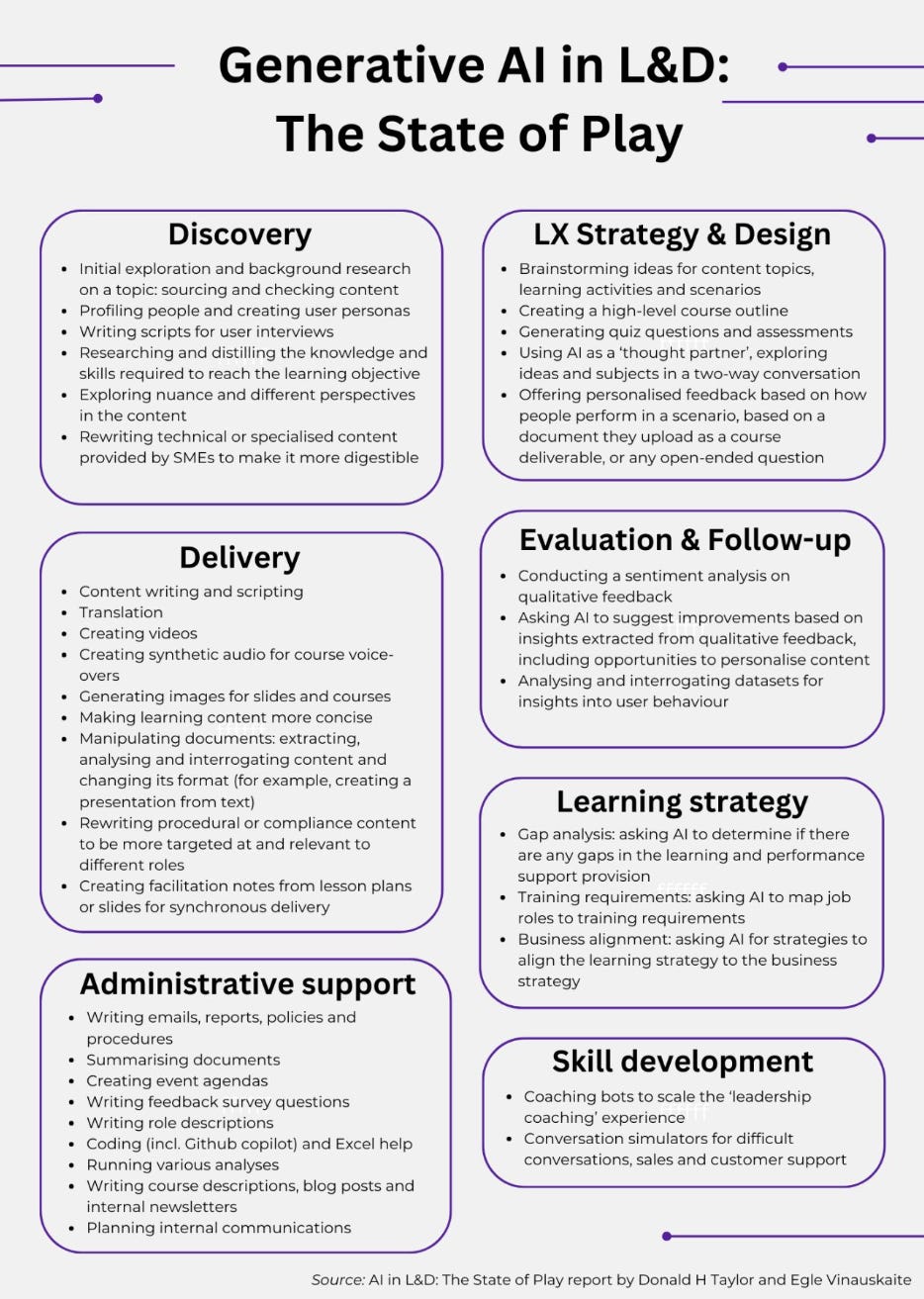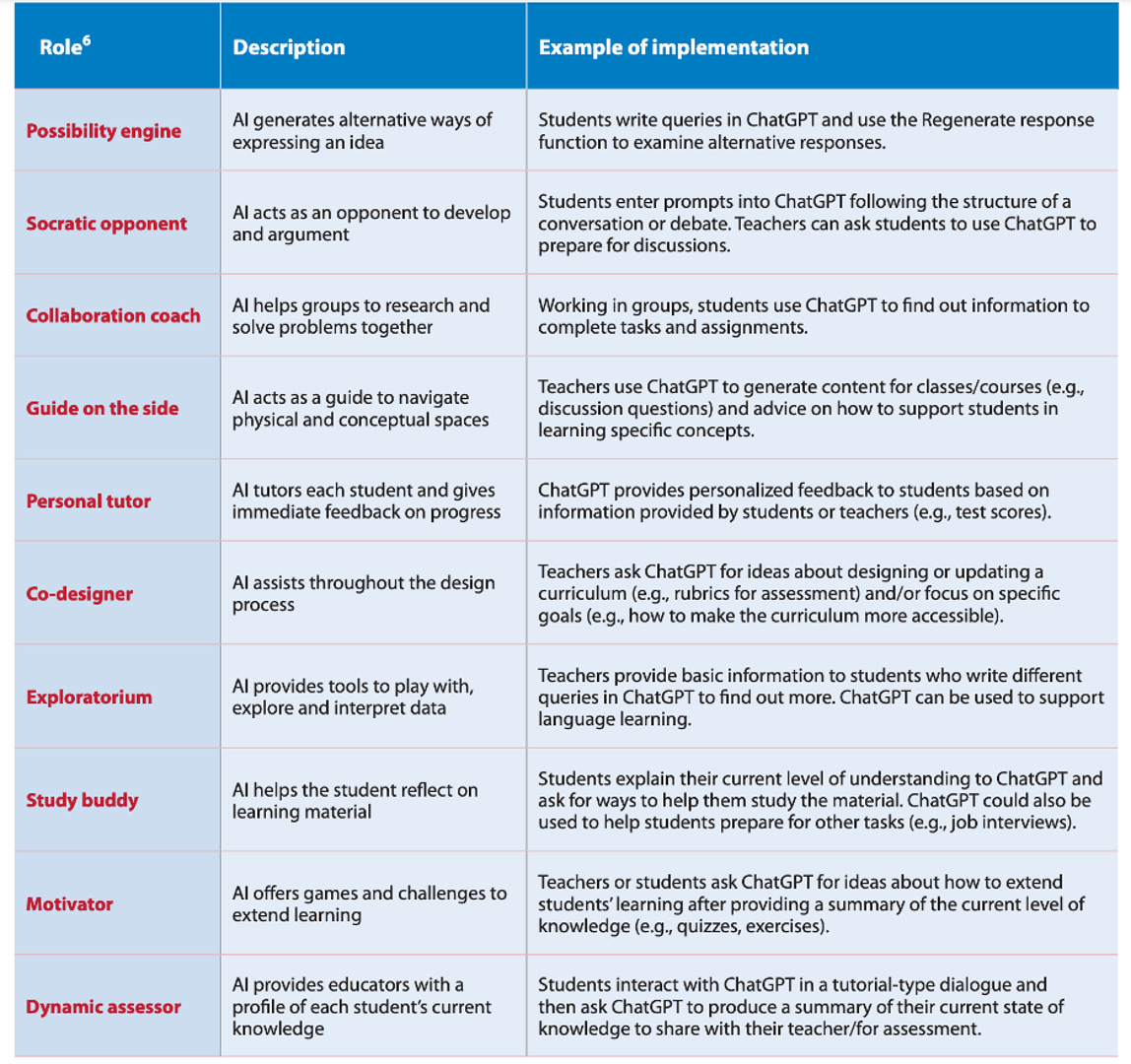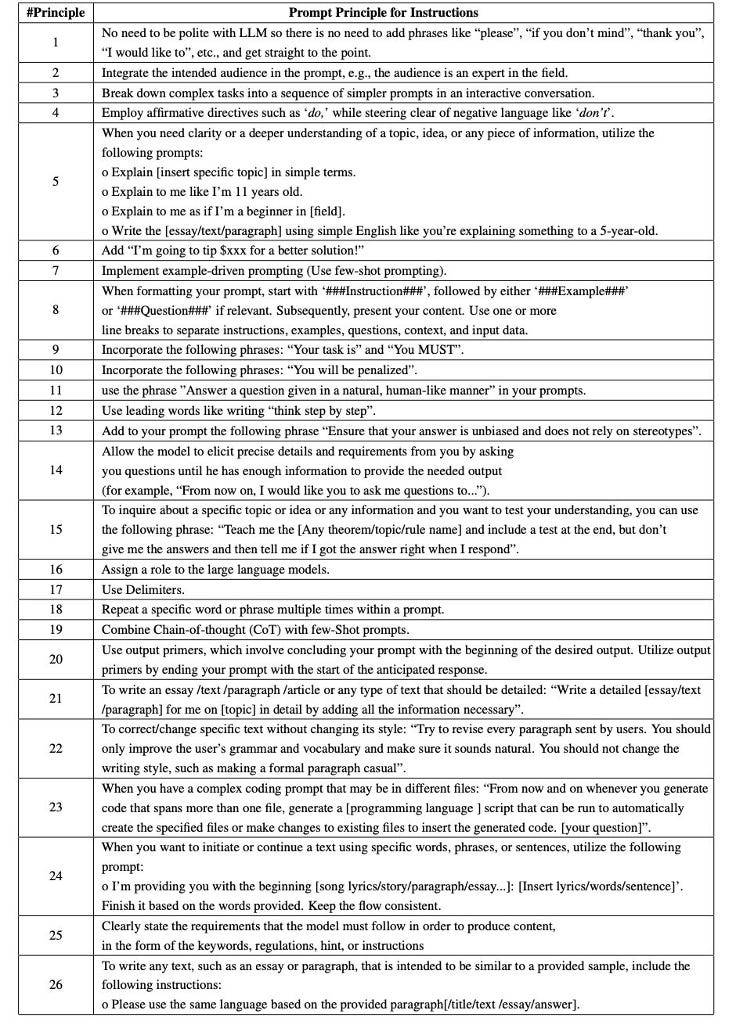Learning & Development is the New Research & Development - How the Learning Function Can be the AI Accelerator
This is Part 2 of a series reflecting on 6 considerations regarding the Learning & Development function investigating, testing and extending the use of AI within your company. Part 1 introduces the Why and is here.
“The AI revolution is the perfect spark that allows L&D to become a major influencer in the future of everything talent, career growth and employee experience. We now finally have the tools we all dreamed of, for so many years, to bring skills to life, amazing new technologies and high impact learning solutions that are aligned to critical company outcomes and employee aspirations.”
Johann Laville, Chief Learning Officer, Merck
As shared in Part 1 of this series, the Learning and Development or L&D function is experiencing a rebirth, or reinvention. While the timing of this may be associated with economic changes, new technical approaches to crafting, deploying and measuring training–particularly in response to Covid and changes to work, the advent of AI and GenAI tools has radically changed our craft.
As a result, we have a new duty or charter to leverage these new practices, and instill new ways-of-working across the enterprise.
When considering L&D is the new R&D as a mantra, recognize that we are already doing this work, and the addition of AI and GenAI tools are unarguably changing our vocation, and perhaps our Purpose or raison d’etre.
6 considerations to be The AI accelerator for your company
#1 Research starts at home. Begin investigating and testing with practical (not hype-driven or too abstract) activities or use cases where GenAI tools and approaches are becoming proof-points in our field. There are plenty of examples from Dr. Philippa Hardman, Ethan Mollick, Donald Clark and others to consider. Egle Vinauskaite and Donald H. Taylor recently interviewed hundreds of L&D practitioners regarding their exploration and expectations and this is a great summary below.1
If this list seems daunting and does not truly help you get started, some considerations or decision criteria to help you explore with confidence:
Where do I already have processes, people, procedures already in place? It’s best to leverage something that exists, and add to or replicate for your new GenAI work.
What work or program already has good cross-functional visibility with other teams or subject-matter experts? While you may feel reluctant to experiment with folks outside your team, the sooner you can build a cohort or micro-tiger team with folks who have a shared interest for success, in the end, this could lead to additional funding and motivated fellow explorers.
Identify the executive(s) who are the sponsors for Operational Efficiency OKRs or similar objectives. These folks want to win, achieve goals and bonuses, demonstrate impact etc. If you get these folks, there’s a greater likelihood they will include you in their strategy AND you will now have ideally gained an executive influencer.
Marc Zao Sanders and I have also suggested a framework for selecting the right project or use case in this HBR article, and may guide your decision(s).
#2 A GenAI Operating System Team. Similar to the Android or MacOS operating system that manages the foundational tasks and most common services for a device or PC, gather a cross-functional team from IT, Engineering, Product, Marketing, HR and of course L&D to identify and evaluate the risks and opportunities of AI and GenAI. The focus of this team may include the following, which has broad impacts to the enterprise…. Note that this approach is gaining steam within the Sales and cross-functional go-to-market (GTM) functions and most recently using AI for ‘in-the-flow-of Selling’ work via Microsoft Copilot. Even company’s Board members are sorting new duties.2 Responsibilities:
AI for Learning portfolio management; i.e., experiments already in the works, results/outcomes gained… Build repeatable playbooks.
Governance approach to bias, ethics, legal, copyright, ESG, public policies
Change management processes including ways-of-working, RACI models, templates & documentation
Unified communications to inform, and given layoffs and new fears of AI taking jobs, the comms and Operating System team needs to be clear that this is about making us all work smarter not another do more with less exercise
Support & consultation to internal teams experimenting with GenAI
Support parallel initiatives such as Digital Experience and Employee Experience
#3 Yep…. Skills, Skills and AI Skilling. Ensure your competency models or skills frameworks or desires to be a Skills-Based Organization include a new or refreshed list of skills to understand this world of AI and its impact on your work, vocation and career.3 Examples of prioritized skills from the WEF's Future of Jobs 2023 Report:
Analytical thinking
Creative thinking
Resilience, flexibility & agility
Motivation and self-awareness
Curiosity and life-long learning
AI and big data
Leadership and social influence
Design and user experience
Data analytics and insights
Service orientation and customer service
Additional skills models and thought leadership definitely includes the non-profit and open sourced Inner Development Goal framework, and (with some followership bias) David Brooks’ work on Essential Skills for Being Human. Sneak peek: The gift of attention. Accompaniment. The art of conversation. Big questions. Stand in their standpoint.
#4 Reality check…. Will AI take my L&D job? For now, there is no argument. AI will take jobs, already has, and the recent saying ‘AI may not take your job, but someone with AI skills will’ rings true. The question about augmentation versus automation versus workforce elimination also remains contentious and there’s an abundance of progressing detail for specific jobs via this Job Impact Index.
However, similar to prior roles where job losses did occur due to new tech, far more new jobs were actually created (great examples: bank tellers versus ATMs in the 80s, and accounting clerks versus Visicalc in the 70’s), we are in the same status or scenario. As noted in September’s WEF report Jobs of Tomorrow: Large Language Models and Jobs, jobs and tasks that are NOT most exposed to replacement regard work that has these 4 characteristics:
Tasks that require intensive use of a language embedded in how Large Language Models or LLMs work, for example mathematical, computational, language translation, data analysis.
Skills or tasks where human-to-human interaction (versus human-to-computer) are more highly required.
Tasks that are non-routine and/or not well defined.
If the work or output is dependent on a regulation, a law, ethical or moral judgment, then this may not be LLM-friendly.
#5 Stay focused on learners, not the hype. As you are all aware, there is a significant amount of noise, confusion, conjecture and debate regarding AI, and this dilutes or possibly pollutes sound judgment. Additionally, while Ethan Mollick and others are correct in this statement, “Today’s AI is the worse AI you’ll ever use”, today’s AI is still biased, and subject to just being wrong.
There are areas though where we can still be Uncomfortably Excited. One very hip and shiny topic regards the use of teaching bots, and coaching bots, and mentoring bots and AI assistants etc.
There is a lot of noise here.
A fruitful example to consider where “teaching assistants” is being more pragmatically modeled is work being conducted by UNESCO4, in particular supporting their Education 2030 Agenda. This is a more comprehensive view keeping the teaching and learning process at the heart of formal education and corporate L&D.
Beyond the contemporary view of AI teaching assistants…
#6 Contain the How to Prompt madness. Prompting or structuring the right instructions with a large language model or LLM etc., is very important and indeed the industry continues to learn. From an L&D is the New R&D perspective, it’s important to focus on ONE prompting strategy; stick with it, and try not to modify your instruction style or principles. Keep in mind that providing good prompting or instruction is just like onboarding an intern, that is someone or something that is willing and eager yet requires context, the Why, training, coaching and management to perform independent work successfully. By sticking with one consistent set of prompting guidance or principles, the quality of your AI intern’s outputs will increase and be more consistent.
For L&D teams and many other teams, this set of 26 Prompt Principles for Instruction is complete, comprehensive and universal for your needs. Note that as your L&D function becomes The AI Exemplar for your company, having a uniform set of guiding principles across the entire enterprise will lead to more effective change management, communications and level-set expectations.
Stick to one model, for now
Our workforce Learning and Development function has had quite a journey, and our opportunity to contribute faster and further has never been more apparent than now, today. From the National Cash Register Company’s (NCR) creation of the NCR Schoolhouse over a hundred years ago, to Ford Motor deploying the Sociological Department to help ‘lower level’ workers’ development, to Bell Labs, IBM, Motorola, GE, Google etc., workforce training is now accelerating due to AI and we are The Table.
As shared, Artificial Intelligence and GenAI tools are our new springboard and our responsibility for the enterprise, and perhaps our communities and society. Be proud, step up, lean in.
Research and develop, to learn and develop.
“Somewhere, something incredible is waiting to be known.”
Carl Sagan
https://www.linkedin.com/in/marcsramos/
Significant thanks for the support and inspiration: Brandon Carson, Donald Clark, Gianni Giacomelli, Dr. Philippa Hardman, Dani Johnson, Cassie Kozyrkov, Ethan Mollick, Mark Oehlert, Noah G. Rabinowitz, Raffaella Sadun, Julian Stodd, Donald H. Taylor, Egle Vinauskaite, Marc Zao-Sanders and so many more.
References
1 AI in L&D: The State of Play (Donald H. Taylor and Egle Vinauskaite, 2023)
2 [Firewalled] 5 steps board members and startup leaders can take to prepare for a future shaped by GenAI (Beena Ammanath, February, 2024) "The urgency to educate board members is growing. Over the last decade, the use cases for machine learning and other types of AI have multiplied. So have the risks. For boards, the AI era has exposed new challenges when it comes to governance and risk management. A recent Deloitte survey found that most boards (72%) have at least one committee responsible for risk oversight, and more than 80% have at least one risk management expert. For all the attention and investment in managing other kinds of business risk, AI demands the same treatment."
3 Putting Skills First Opportunities for Building Efficient and Equitable Labour Markets (World Economic Forum, January 2024)
4 ChatGPT and Artificial Intelligence in higher education Quick start guide (UNESCO International Institute for Higher Education in Latin America and the Caribbean, Education 2030)
A Framework for Picking the Right Generative AI Project (Harvard Business Review, Marc Zao-Sanders and Marc Ramos, March 29, 2023)
Microsoft Copilot for Sales and Copilot for Service are now generally available (Emily He, Corporate Vice President, Business Applications Marketing, February 2024)
Inner Development Goals: Background, method and the IDG framework
The Essential Skills for Being Human (New York Time, David Brooks, October, 2023)
This is why the idea that AI will just augment jobs, never replace them, is a lie! (Plan B, Donald Clark, February, 2024)
There’s an AI for That: Job Impact Index
Toil and Technology (Finance & Development,, March 2015)
Reality by the Numbers – What the Spreadsheet Has Done to Us (Aquatics Informatics, June, 2017)
Principled Instructions Are All You Need for Questioning LLaMA-1/2, GPT-3.5/4 (Sondos Mahmoud Bsharat, Aidar Myrzakhan, Zhiqiang Shen, December, 2023)






